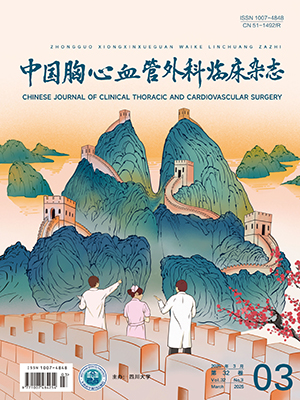Abstract: Objective To investigate videoassisted thoracoscopic surgery (VATS) and percutaneous catheter occlusion (PCO) in interruption of patent ductus arteriosus (PDA), in order to achieve minimally invasive surgical injuries and better clinical results. Methods From November 1995 to September 2009, 312 cases of PDA were treated in Fujian provincial hospital, among whom 252 patients were interrupted with VATS(VATS group) and 60 patients with PCO technique(PCO group). For the VATS group, there were 78 males and 174 females aged from 7 d to 31 years old (9.16±8.91 years), while there were 17 males and 43 females aged from 4 to 57 years old (25.55±14.10 years) in the PCO group. We used titanium clip to interrupt PDA under videoassisted thoracoscope for patients in the VATS group, and adopted Amplatzer method for patients in the PCO group. The clinical results, complications and hospital cost in the two groups were compared in this study. Results In the VATS group, all the PDA were successfully interrupted with no residual shunt. In the PCO group, 5% (3/60) of the patients had minor residual shunt after the procedure. No mortality occurred in both groups. Time of the procedure and hospital stay in the PCO group were shorter than that in the VATS group (70.20±31.20 min vs. 112.50±16.30 min, t=6.344,P=0.002; and 4.70±2.20 d vs. 6.50±2.80 d, t=3.241, P=0.022, respectively). However, the hospital cost for each patient in the PCO group was much higher than that in the VATS group (23 222.00±4 333.40 yuan RMB vs. 8 904.50±2 634.60 yuan RMB,t=25.360, P=0.000). Conclusion Compared with PCO, VATS in interrupting PDA can achieved not only excellent clinical results, especially in the newborn and baby cases, but also very satisfying cost which is just a little more than one third of the PCO cost.
Citation: WENG Guoxing,CHEN Zhiqun,WANG Huan,et al .. Comparative Study between Videoassisted Thoracoscopic Surgery and Percutaneous Catheter Occlusion in Interruption of Patent Ductus Arteriosus. Chinese Journal of Clinical Thoracic and Cardiovascular Surgery, 2010, 17(5): 370-373. doi: Copy
Copyright © the editorial department of Chinese Journal of Clinical Thoracic and Cardiovascular Surgery of West China Medical Publisher. All rights reserved




